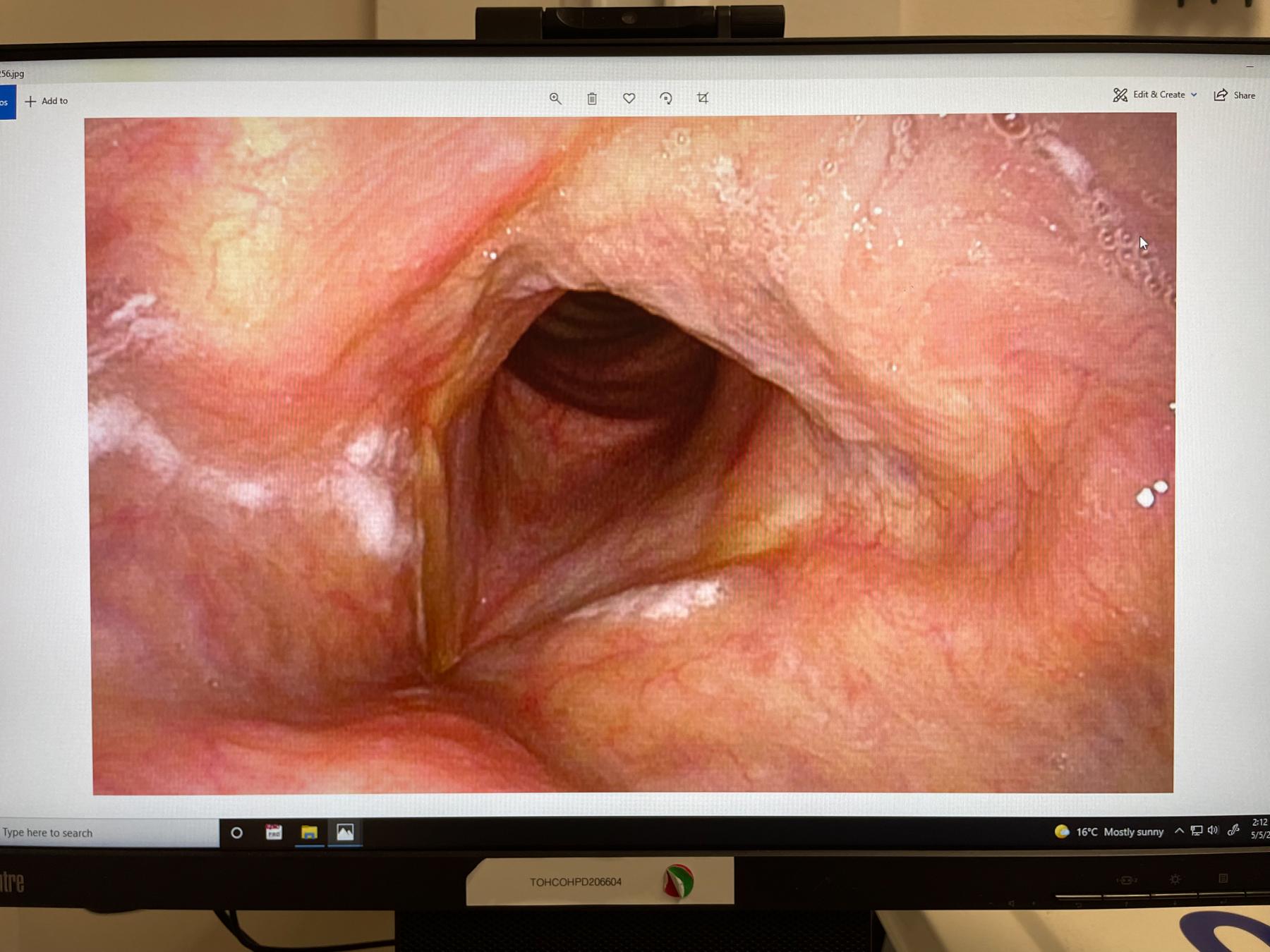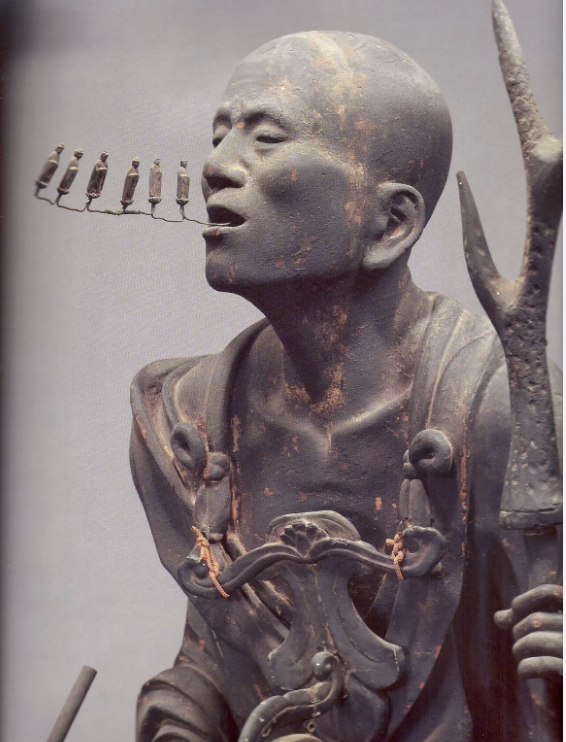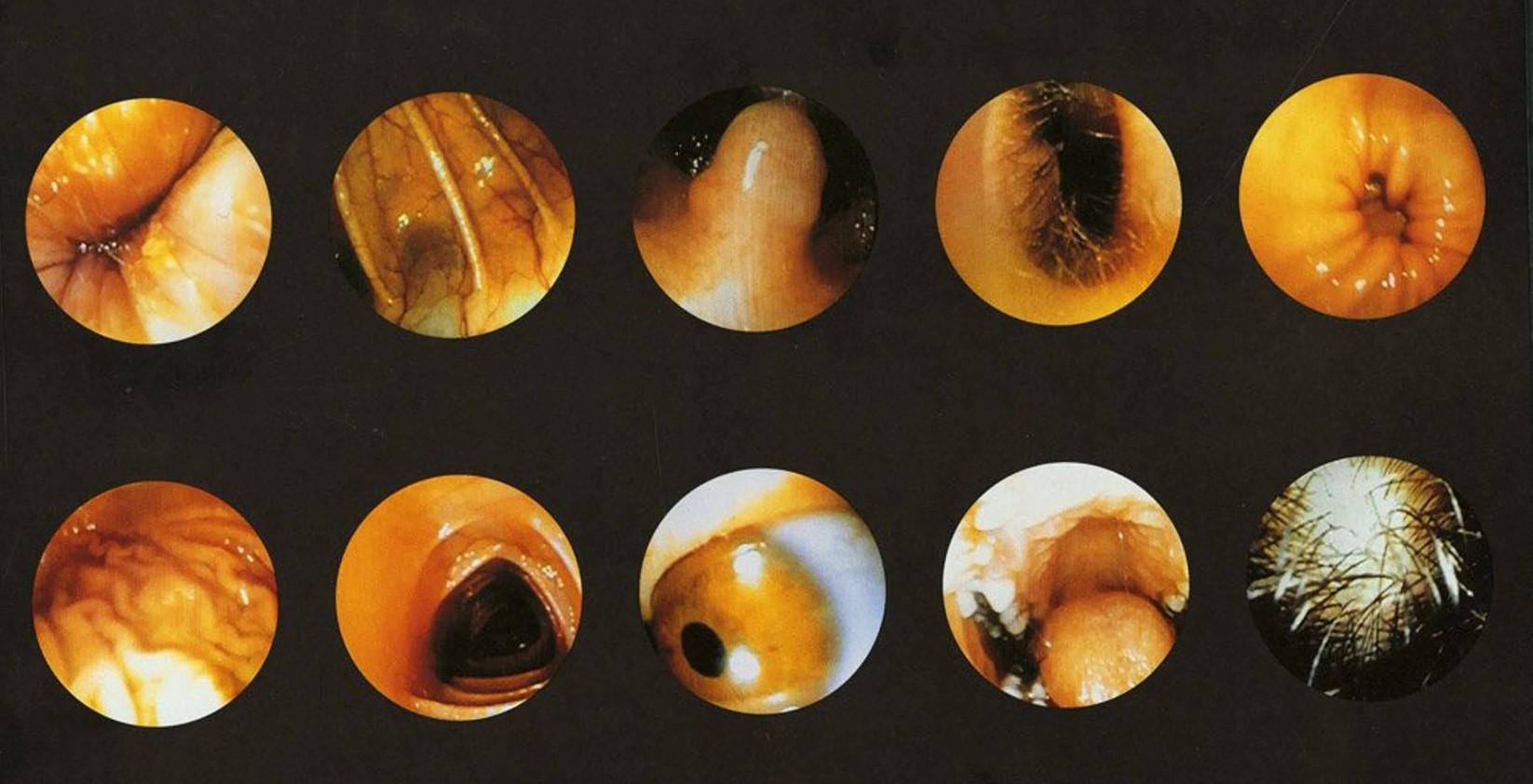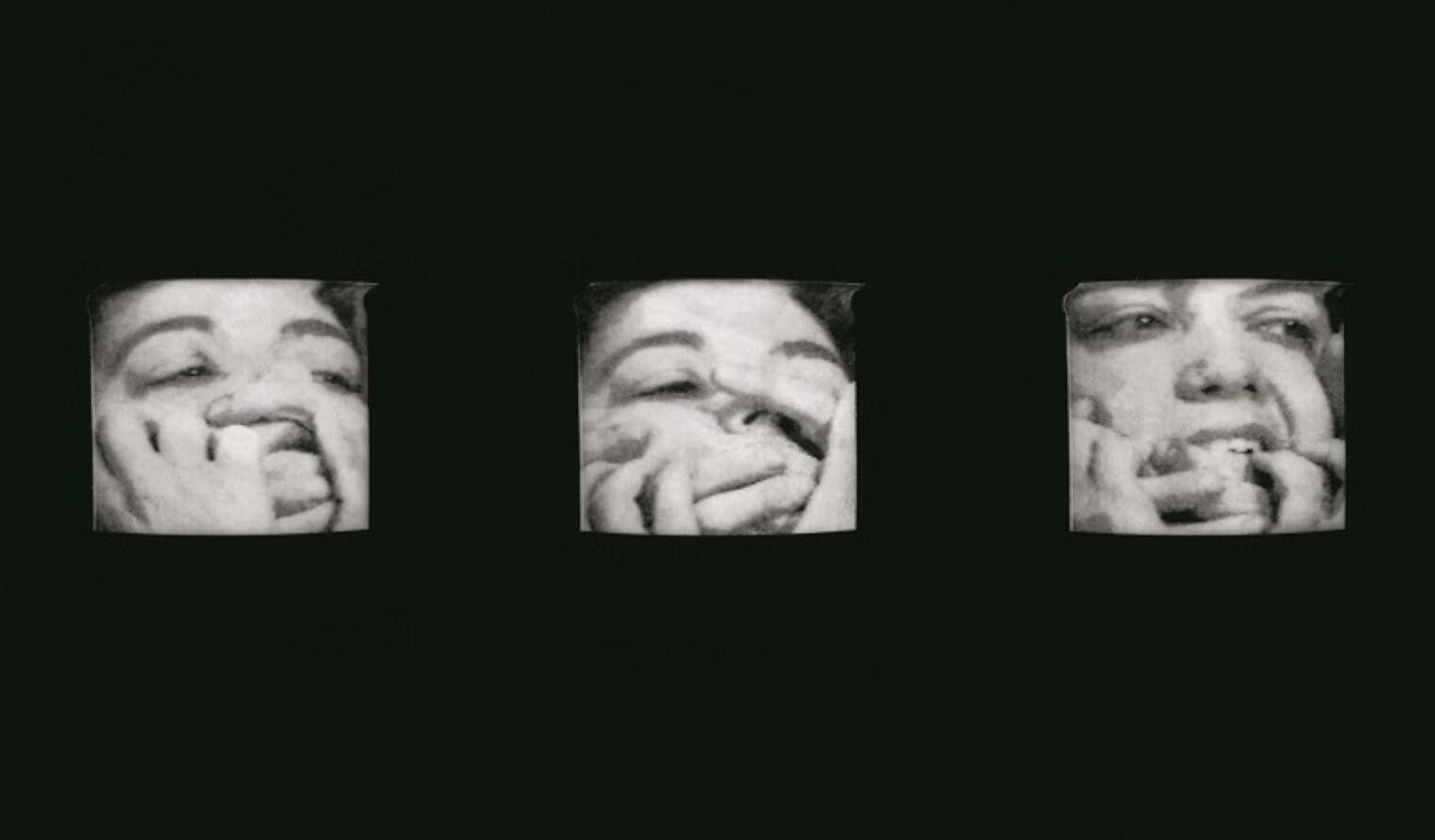I was pleased to hear that the incision would run from one side of my neck to the other, following a natural wrinkle. The original plan was to begin a descending cut under one ear for several inches, then proceed across the neck and back up to the other ear – a “horseshoe incision” that wouldn’t age as well. In any case, I was facing a bilateral neck dissection to remove a large malignant tumor on my thyroid and an unknown but significant number of affected lymph nodes in the area. To my relief, this was a curative operation with a high rate of success and a prognosis for a statistically “normal life,” which, during the first several months post-op, felt anything but normal. My old voice was gone, and I didn’t know what to make of the new one. Although vocal paralysis is a risk in a total thyroidectomy, I had avoided this fate thanks to sophisticated nerve-monitoring gadgetry, but I emerged from the operation with a kind of breathy cookie-monster voice that, two years on, has settled somewhere in the vicinity of a fashionable vocal fry.
My kids are asleep upstairs in their mother’s bed. I hear the pulse of the dishwasher and the mess of today’s April snowfall outside whenever a car passes. Besides that, it’s quiet. The last thing I saw on my phone before I placed it face-down on my chest a half hour ago was a shaky clip of two shell-shocked girls, about the same age as my kids, collapsing into one another for comfort on the floor of an improvised medical clinic somewhere in Northern Gaza. They may have been sisters. Tenderly, they looked at each other and touched like sisters. The eldest lifted her head just high enough to give the littler one a kiss on the cheek. It may have calmed the wailing, but I can’t be sure. The sound was off, as it always is this time of night while my girls are sleeping.
When I was in my doctoral program at McGill, Jonathan Sterne, one of the professors in the Department, had a thyroidectomy too, also for papillary thyroid cancer. I didn’t take any seminars with him as he was on the Communications Studies side of the Department, and I was on the Art History side. But he was beloved by his students and colleagues, and I admired his path-breaking scholarship on the MP3 format and the history of recording technologies. I bumped into him in the hall after he returned to work and his voice was weak, but assertive enough to correct me when I remarked in error on the “irony” of a vocal impairment befalling a sound studies expert. Graciously, he offered: “it’s an unfortunate coincidence.” At the time, I had a lump on my neck that looked like a second Adam’s apple. Though I didn’t know it, while Prof. Sterne began writing his book on the “political phenomenology” of his and other impairments, my benign thyroglossal duct cyst was turning malignant.
There’s a lengthy meditation at the beginning of the book on what, exactly, a voice is. His description of the mechanics of vocalization is precise and brief, but the philosophical conundrum of voice as inherently significant, as an intellectual or spiritual substance, power or medium, customarily associated with the mouth but impossible to pin down there or anywhere else, preoccupies him for most of the introduction. The voice is a highly mediated thing; this much is certain, and a predictable starting point for a media historian of our “audible past.” But for Sterne it’s irreducibly mediated, relational, or always between at least a couple of things, from its moment of production between the vocal cords, to its transmission from a speaker to a listener, and on either end of that circuit the splitting and mediation continues – speech is delivered and received on the wings of language and thinking, or feeling, or neither, when it falls instead of flying. It’s very often not delivered, or not received, escaping between the poles of thought and feeling but nevertheless consisting, or so we imagine, in what’s called a voice. For someone who has lost their voice, Sterne’s account of its essential fugitivity, its diversions and errantry, its habit of falling short of perfect resonance or clear understanding, is a comfort. A voice can’t really be lost where one, a definitive one, can’t be found in the first place.
Sterne’s consolation stayed with me through the night, after I laid the book down on my chest. The fullness, humor and wisdom of his voice, as a writer, was passed on to the voice that I read with, without making a sound. Reading too is a consolation, I guess. But mornings, I often struggled with the visceral experience of loss and impairment. Although my voice is best in the morning, I must be circumspect in my routine projections as vocal fatigue worsens throughout the day. If I don’t try too hard, I sound okay, normal, when I tell the kids ‘Good morning.’ I started to think of this first utterance of the day as a pace-setter, or a reminder that saying that, at least, shouldn’t be so hard. I still push boundaries for charisma, or to fill a space with my voice, or to convince, but I pay for it if I’m not careful. I know I’m more comfortable when I respect its limits and allow it to escape, as voices tend to do, or to rest, as they must. Besides, my kids are more than happy to fill in the acoustic space I relinquish. I talk for a living and have likely already broadcast much more than my share of words in this world. But I also write for a living, with a voice that doesn’t require the same kind of effort. I write like an academic sometimes, or a fan, or a critic. These are voices too, like others, more-or-less impaired, more-or-less normal, and upsetting to me when formulaic, rote, or canned. These voices, like any, are just as inclined to stray as they are trusted to land properly where I aim them, typically at or near the images I study.
Images like a pair of self-portraits – endoscopic photographs of Sterne’s larynx, with vocal cords opened in one to form a thin slit which closes in on itself in the other. I missed my chance at a throat diptych from my own endoscopy, but I did get a single iPhone shot of the live feed from scope to screen in the clinic. My selfie is more vascular and moist-looking than the cool black and white reproductions in Sterne’s book. My larynx is wide open, but there’s a noticeable asymmetry. Whereas his slightly open cords describe a “vertical ovular gap,” mine are apparently on the lean, vertical on the left side where one is discernible and falling at about a 45-degree angle on the right where the cord is crowded by fatty tissue. My voice production was permanently limited by this tissue, which, when closed against the exposed cord would muffle its sound. Vocal sound is modulated by the vibration of two cords in proximity like a clarinet’s reed, or a thick blade of grass folded between the outside edges of the thumbs to make a whistle. The otolaryngologist who took the image had some decorous musical analogies for explaining my troubles (i.e. limited tonal range; inability to project or yell; reliable late-day vocal fatigue), but I only remember the one I came up with after the appointment: my voice was like music you’d make playing a violin with a fish. When I walked into that clinic several months post-op, I was hopeful about a surgical or other solution. But the news was not so good. The doc said risk of further damage, even paralysis from corrective surgery was not worth the attempt. The image I saw and kept on my phone of that torqued, fleshy void was final, physical evidence of a current and permanent impairment.

Author’s iPhone image of endoscopy. Ottawa Hospital Civic Campus. May 5, 2022.
Evidentiary images of lost voices are everywhere these days. Awhile back, after the ICJ ordered Israel to end all acts of genocide, some damning drone footage of an air strike on four young men in Khan Younis, Gaza made the rounds. According to the news sources Middle East Eye and Al Jazeera, the men were apparently unarmed as they walked along the road through a bombed-out neighborhood, perhaps in search of survivors. Seconds before the first strike one of the men raises his arm in an exasperated address to the others. As it falls back to his side, in stride, a blurring filter is applied to the whole group just before the first explosions. Stains left behind on the dirt road are blurred as well. The drone pulls back for a longer, unfiltered view of the road and then closes in again on one of the men walking at a strangely unrushed pace from the blast, carrying his coat under his arm like anyone might on a day of misjudged weather. He’s caught in the filter, and in short-order disappeared by another blast. The footage is cut, and then resumes to show the last of the four (dead) men walking much more slowly. He catches the sole of his shoe on a ridge in the road left by a tank, falls to his knees, and begins crawling before he too is enveloped by the fatal blur, and blown to bits. The filter is tightened in a still image showing just the missile a couple of feet over that fourth target – the white line of it runs parallel to a ridge like the one that caught the man’s shoe. Details like this are available beyond the edge of the blur, which is synchronized with the precision lock of the targets in IDF crosshairs – clarity is sacrificed to what Susan Sontag once called “an ecology of images,” but the evidence of slaughter is no less compelling. The pictures are silent, and final. Nothing more can be done with them, and it would seem, nothing can be done to stop more from coming. Evidentiary images don’t always provide a last word. But the silence of these men’s lost voices, and those of over 30,000 others at the hands of the Israeli military is deafening.
Still image of Khan Younis aerial strike, from Middle East Eye

Kosho, portrait statue of the Buddhist priest Kuya preaching,
Kamakura period, early 13th c.
A violin and a fish kept my case open, contesting the finality of that endoscopic image with something looser, silly or surrealistic, and figural. In Sterne’s book art is pressed into a similar kind of service, opening the voice onto its various interpretive horizons, from the Mayan civilization to Early Modern Germany, and into our age of bio art and data visualization. In the “Volutes Room” of his imaginary exhibition we encounter a Meso-American stela showing a speech scroll emanating from the mouth of a figure with snakes for legs. On the next page, a banderole rising in curls from an angel’s lips over a weeping St. Anne in Strigel’s The Annunciation to St. Anne (1505 – 1510) follows the idea of voice from magical into prophetic territory. Moving through Sterne’s virtual room, I recalled a sculpture of the Heian period Buddhist monk Kuya from a textbook I assign in my “Introduction to Art History” course. I had presented it several times excitedly to students before the surgery, but afterwards it took on a heavier, quieter resonance which I was careful in class to keep private. In it, the revered monk who lived through plagues, earthquakes, floods, and several uprisings, is shown uttering six syllables of a chant, broken down into a line of small Buddhas advancing like distinct puffs of smoke from his open mouth. The representations of voice we get from contemporary Palestinian artists are a good deal less enchanted – where prayers have failed, they resort to pleas.
In 1993 the London-based Palestinian artist Mona Hatoum found a doctor who would help her make an endoscopic video art piece called Corps Etranger (1993). The camera begins its journey on the surface, brushing the artist’s eyelashes and passing over the contours of her face, skipping off them like a clumsy low-flying plane looking for a place to land. At first, we hear her breathing only. After a few seconds the camera finds its way over the lips, past the teeth and into the artist’s mouth before a deeper descent through the throat and upper digestive tract, during which the breathing gives way to the thrum of a circulatory system. I think I recognized the larynx on the way down but I’m still not sure – it’s a strange land indeed, when the inside of a body is turned outwards for us to travel across visually. Another video work by Hatoum called So Much I Want to Say (1983) is also a kind of travel log. Originally recorded at the Western Front in Vancouver, the image of Hatoum trying and failing to pry a man’s hands from her mouth, was transmitted in wobbly fits to a gallery in Vienna. A vertical roll interrupts the grainy black and white image as she lethargically repeats the title: “so much I want to say.”

Mona Hatoum, Corps Etranger

So Much I Want to Say (1983)
In the months leading up to the second Intifada, the late Palestinian-American literary scholar Edward Said reflected on the theme of “displacement” in Hatoum’s art. He focused mostly on her unheimlich sculpture installations, but he might have included the two videos in his inventory of her disorienting transitions. He does a fine job describing the tendency anyway, with an allusion to the itinerary of Johnathan Swift’s Lemuel Gulliver, from a port of heroic departure in England to a shipwrecked encounter with tiny human-like captors slinging arrows at him on a beach in the fictional Lilliput. Hatoum is a fallen giant as well, when we wander through her body with a camera, and then in the low-fi transmission, find her struggling against anonymous, immovable hands. But there’s another passage in Hatoum’s body of work, from what Rosalind Krauss called “the aesthetics of narcissism” in early video art to a self-effacing and historical claim on behalf of Palestinians in the diaspora, and those under occupation, or in IDF crosshairs. For Krauss, the narcissistic decision to turn a camera on oneself or, in Hatoum’s case into oneself, is a problem if it’s done without making the mediating role of the apparatus, or the medium of the artwork conspicuous. Hatoum is off the hook in this regard, as she draws quite a bit of attention to her tools and their constraints in the videos, to the art of the artwork. But maybe narcissism isn’t a dodged formal problem for her, so much as an aspiration. Imagine a world in which a Palestinian artist like Hatoum could make work that was simply, indulgently about herself, her body, her voice and all the things she might say without hands pressed down over her mouth.
Or maybe there’s more to be said for and in silence. The Montreal-based Palestinian filmmaker Rehab Nazzal’s Vibrations from Gaza (2023) follows the lives of a few charming students at the Atfaluna Society for Deaf Children on the coast in Gaza City. The coast is beautiful, and the kids are shown enjoying it, playing in the waves and at the shore with squirt guns and homemade kites, or beachcombing for shells, jetsam, treasures. They describe the titular “vibrations from Gaza,” of drones overhead and explosions in the distance, in sign language for Nazzal’s camera with effortless charisma and expressiveness, and without a sound. But the ominous hum of a drone is heard throughout the film, like the one that stalked those four men in Khan Younis. After the 15-minute run-time it’s all one hears, resounding faintly, repeating itself like Hatoum’s refrain: “so much I want to say.” Alas, the school was bombed and there’s a picture floating around on Instagram of a few self-satisfied IDF goons posing arm-in-arm in front of its floodlit ruins. I carried the sound of those drones in my head to bed after watching Nazzal’s film. Do the soldiers like the noise they make? Sterne describes something like this in the heavy metal and noise music scenes, a voluntary subjection to damaging levels of sound. He calls it “audile scarification.” The kids of Atfaluna didn’t choose their loss of hearing, but we can choose to listen, and look, and suffer the consequences, and sadly our suffering may count more than theirs does to stop the still-rising death toll in Gaza. It’s a dismal hope but one of only a few I have left.

Rehab Nazzal, Vibrations from Gaza (2023, Poster)
I can’t hit those f-sharps in the shower anymore, but I’ll get over it. My new plan is to brush up on my Arabic, learn some velvety Muhammed Abdel Wahab songs, and settle into the tonally low life. My voice hasn’t disappeared, but the old one is gone and I’m still finding the one I like, for now. Sterne’s book hastens the disappearance of the voice associated with a unified and stable Western philosophical subject. Good riddance. In its place he finds a mediated voice and a radically decentered subject, shuttling between various identifications that serve at times to form fragile political communities. But the consequences of this post-humanist turn for Palestinian and other rights movements might be tough to swallow. As important as it is to let go of essentialisms, the need for assertions of Palestinian identity grow more urgent each day. Strong, angry, and loud statements against the murder of Palestinians are necessary. I want to do nothing more than scream when I see evidence of it in my horrific news feed, but I can’t anymore. I consume those images quietly, and I’m trying here to not consume them passively. Hatoum doesn’t scream either, nor do the kids of Atfalun whose activity is so eloquently hushed, and we look and listen more attentively as a result. Surrounded by the noise of war criminals, quiet voices move in closer.